|
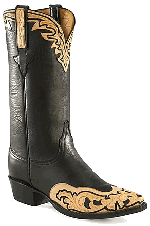







|

From a report by Norman B. Livermore,
Jr. |
This article was originally published
in July 1990 copy of
"The Album: Times & Tales of Inyo-Mono"
by Chalfant Press.
See USE NOTICE on Home Page.
|
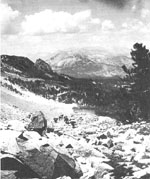
Over Duck Pass
to Barney Lake
(Kelsey Sierra Studios Photo)
[Mammoth Lake Pack Outfit] |
"Ike
Livermore did this study more than fifty years ago, and little
has changed," mused Bob Tanner when he handed over a faded
copy of "The Tourist Packing Business of the High Sierra
Region," by former packer and California State Administrator
of Resources Norman B. Livermore, Jr.
Tanner
should know; he has been in the industry for years and is the
force behind Red's Meadow Pack Station, along with other enterprises.
Livermore
was Secretary for Resources from 1967 to '74 under Gov. Reagan,
and a member, later president, of the State Fish & Game Commission
from 1980 to '84. In 1934, with the help of Allie Robinson, one
of the first eastside packers, he organized the High Sierra Packers
Association and became a major influence in decisions beneficial
to the wilderness and packing industry. At one time he owned
the largest pack train in California, being a partner of the
Mineral King outfit (1929-46) and of Bruce and Charles
Morgan and Tommy
Jefferson of Mt. Whitney Pack Trains based in Lone Pine (1946-73)
His report, compiled in 1935, was prompted by an assignment at
the Harvard Graduate School of Business, where he was studying.
In the autumn of 1934, motorcycling between Tioga and Walker,
he interviewed packers on both sides of the Sierra.
|
At
that time, 22 packers operated in Inyo and Mono counties. Thelan
covered Kennedy Meadows; Sam Lewis Haiwee Canyon. Going into
the Olancha area were Barney Sears, Dan Cook and Dick Burns out
of Olancha, and Burkhart & Olivas from Lone Pine. Dow of
Jordan Hot Springs went into the headwaters of the Kern, South
Fork, from Lone Pine. Wally Wilson and Chrysler & Cook packed
into Lone Pine and Carrol creeks.
From
Independence, C.H. Hyers' Circle Dot Pack Train, Archie Dean
and Allie Robinson took visitors into the back country through
Onion Valley. Allie Robinson was the largest outfit, with 170
head of stock, and took trains out through Symmes Creek, Oak
Creek, and Taboose as well as Onion Valley. R.H. Logan operated
out of Big Pine Creek.
From
Bishop, George Brown had the Pine Creek string, Cecil Thorington
McGee Creek, Art Schober was listed for Bishop Creek, as was
Halliday's Rainbow Pack Outfit at Parcher's Camp. Vance Brown
packed out of Hilton Lakes Resort and D.G. McComber's Broken
Bar Outfit went into Rock Creek Lakes region. Lloyd Summers'
Mammoth Camp Pack Outfit went out from Mammoth, Agnew Meadow
and Lake Mary. McGuffin's Lake Mary Pack Outfit also operated
out of Lake Mary, while Slim Tatum covered the Silver Lake passes
from his June Lake headquarters.

Rainbow Pack Outfit, 1960
(Mammoth Lakes Pack Outfit photo)
To
tell the adventures, history, campfire tales, and relationships
of these pioneer packers to families throughout the two counties
would take at least a thick volume. George Brown, for instance,
was a respected Chief of the local Paiute Tribe; Brown, Tatum,
Summers, Thorington, Schober, Olivas - all are familiar names
with families firmly tied to the area. At least one campfire
tale deals with who shot the coffee pot out of whose hands for
harassing his flock of trippers!
|
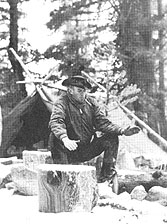
First snow at
Deer Creek. Packer Hugh Avery, 1961.
(Mammoth Lakes Pack Outfit photo) |
Seriously
Enough
by Jane Fisher

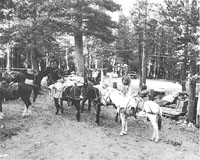
Deer season 1961.
(Mammoth Lakes Pack Outfit photo) |
Livermore
wrote of a High Sierra packing experience for the 1977 (8th Annual)
Mule Days program. He told of feeling mighty lucky to have been
assigned one of the 13 strings of mules used by Allie Robinson
on a Sierra Club trip in 1938.
"First
of all," he wrote, "Hightrippers don't see anything
at all of the preparations at Independence or the deadheading
to the point where the Club is first met. To the packers, these
are in many ways the highlights of the trip."
When
"Ike" arrived at Independence, he found the corrals
a busy place, with packers arriving from all over the Valley.
"Most of them, with a goodly sprinkling of Independence
corral-fence sifters, were watching Allie at work in the corrals.
Here, with two or three helpers, he was selecting out of more
than 150 head the horses and mules that were to go on the Club
trip.
"The
stock was pretty well shod up, because Pete Buckley had been
on hand for several weeks to tend to the exceedingly tough job.
And if you don't think I mean tough, just try and shoe a bronc
mule some time. This year, there were ten of them on the High
Trip. Allie says he wishes Luther Burbank had been a stock breeder.
He might have been able to develop a strain of mules that are
born with their shoes on!"
Each
packer was issued his gear: pack saddles with rigging, pack blankets,
snap ropes, a bell and a blind. They furnished their own saddles
and equipment, including bedroll (weight not over 75 pounds!).
During the four-day deadhead up the Valley, "no one seemed
to know or care who the cook was going to be until after the
fire was started. There was no grate, no equipment except frypan,
coffeepot and stewpot. Dish washing was a hasty if not painstaking
chore, and the drying was mostly done by air (circulating naturally
over a used mule pack cover). But everyone got happily and healthily
nourished, which after all is the main thing. In the evening
we'd sit around the campfire awhile where the favorite occupation
was to 'run mustangs,' i.e. to lay dreamy plans for capturing
wild Nevada horses. This didn't last far into the night, though,
because the regular rising hour was four.
|
|
"Hightrippers'
opinions of packers seem to range all the way from disdain through
indifference up to admiration," Livermore wrote. "Packers,
on the other hand, have a rather uniform and understandable if
not quite fair opinion of the Club members" . . . "a
feeling of good natured sympathy which is best expressed by the
term 'footburner.' Packers, born and raised with stock, never
have been able to see how people could derive pleasure from hiking"
. . . "they feel genuinely sorry for what they regard as
misguided souls burning their feet up. And when it comes to rock
climbing, of course, a packer definitely loses all sympathy and
comprehension. The whole subject is completely beyond him, and
its devotees are living examples of life's endless mysteries."
One
of Livermore's proudest accomplishments was to stop the construction
of a trans Sierra Minarets Road which would have cut the John
Muir Trail in half and greatly depreciated the High Sierra Wilderness.
Construction of roads and dams on the westside reduced the need
for packers there, and of 48 in 1936, less than a quarter are
still in business. Of the 71 pack trains working both sides in
1935, fewer than 50 remain.
Nonetheless,
Old West courtesy still prevails, with packers prepared to make
every wilderness trip a memorable experience. They will plan
and prepare meals; they will chase and tend the animals; you
may ride or walk; they will drop you off, stay with you, or drop
your gear at your destination and haul it back out when you're
ready to leave. They will arrange guided fishing, hunting, and
exploring expeditions, or an outdoor college course. Learn fly-fishing,
mountain cooking, painting, photography, flora and fauna, horsemanship.
Go alone, with friends, meet new friends, or take the kids. Smell
the coffee in the sharp morning air, hear the birds and splashing
water, look into vast distances, eat the trout you just caught,
feel the quiet.
"We
are an old-style profession in a high-tech world," says
Danica Berner of Pine Creek Pack Trains. A truly comforting thought.
|
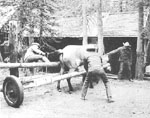
Red Altum, Lou
Roeser and Carl James branding horses in 1961.
(Mammoth Lakes Pack Outfit photo) |
Typical grub
list for 16 people for 10 days
(Courtesy of C.H Hyers'
Circle Dot Pack Train) |
|
1
hind
10 pounds
1 sack
12 large cans
6 one pound cans
24 cans
2 rolls
12 large cans
2
2
12 No. 10 cans
25 pound sack
2 medium cans
50 cents
1 package
1 case
25 pounds
10 cents
5 pounds
5 pounds
12 large
1 shaker
5 pounds
10 pounds
5 large cans
5 large cans
1 large can
1 package
5 packages
10 pounds |
Hind
quarter beef
Canned butter
Potatoes
Pork & beans
Coffee
Milk
Jack cheese
Tomatoes
Hams
Bacons
Peaches & pears
Flour
Baking powder
Onions, dry
Arm & Hammer baking soda
Eggs
Beans, dry, pink
Garlic
Peaches
Apricots
Spaghetti
Salt
Crisco
Rice
Sauerkraut
Hominy
Tea Garden syrup
Tea bags, black
Beeman's gum
Christmas candy, hard |
|
Thanks to Brad Braune for allowing me to use his paintings
as backgrounds on these pages.
|
|














